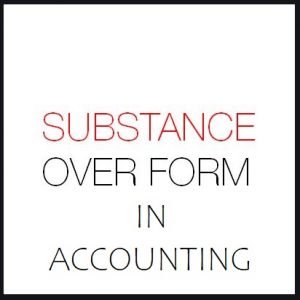
Substance Over Form is a term that is synonymous with Accounting, if you are an accounting or business inclined students or individual, then this should not sound new to you most especially auditors of financial statements. However, the meaning of this accounting concept has been misinterpreted over the years and it is time we define what Substance Over Form in Accounting or corporate world is about as well as how to identify the substance of a transaction when faced with such task.

What Is Substance Over Form As An Accounting Concept?
Substance over form concept in accounting is defined as an accounting concept which demands that transaction and other events should be accounted for and presented in accordance with their substance and financial reality and not merely with their legal form. This is a very important accounting concept that forms the foundation and base for financial accounting reporting.
Remember that the purpose of financial reporting is to provide user group with neutral and objective measurement of business performance. Information contained in published accounts is expected to be fairly and accurately present the corporate performance during the period.
In practice, some preparers of financial statement are engaged in manipulations of accounting figures so as to exploit choices available, within existing accounting regulations and generally accepted accounting practices. Oftentimes, transactions are structured in a way that if reported in accordance with its legal form, the apparent position differs from the underlying economic reality. Many “artificial transactions have been developed with the intention of making financial position of an entity look better than it actually was. The aim of these practices is to transform financial statements from what they should contain into what the preparer would
prefer to see reported. These manipulations are generally referred to as “Creative Accounting” or Window Dressing”.
Substance over form is not defined in or guided by any IAS/IFRS but there are certain transactions that raise suspicions about their treatment. In general the following characteristics suggest that a transaction’s commercial substance may be different from its legal form:
(a) Separation of the title to an item from its risks and rewards. For example, an enterprise may sell an asset to a third party, but retain the right to use the asset and the risk attached to it.
b) Linking two or more transaction together. Often, the commercial effect can only be understood when the series of transactions is considered as a whole.
(c) Including option in a transaction. An example of these last two characteristics is the sale of an asset with an option to repurchase it at a below market price.

How To Identifying The Substance of a Transaction
The substance of a transaction is determined by looking at its effect on the balance sheet. The key feature of many of these transactions is whether or not a sale should be recognized and the related asset derecognized. This is done by identifying the asset and liabilities recognized in the balance sheet before and after the transaction. The substance of the transaction will be reflected by the change in these items. For example, if an asset recognized before the transaction has been derecognized, then there has been a sale. If there is no derecognition, then there has no sale and the transaction is probably a secured loan.
Examples of transaction that can further raise suspicion on substance over form enumerated overleaf:
1. Consignment Inventory
These are inventory held by one party but legally owned by another on terms, which give the holder the right to sell the goods in the normal course of their business, or at their option to return it unsold to the legal owner. It is common in the motor trade. Small car dealerships would be unable to finance a showroom full of car, and so manufacturers allow dealers to delay payment unit the cars have been sold on to the final customer. The
manufacturers normally retain legal title to the cars until they have been paid for in full.
2. Joint Ventures
A joint venture should be subject to the joint control of the investing parties. However, in practice, one of the investors may be able to exert de-facto control, be able to claim the majority of the profit or be exposed to the majority of the losses. This inventor should treat the Joint venture as a subsidiary. The ability to exercise control or claim the lion’s share of the may be evidenced by management agreements and management charges, rather than by shareholdings.
3. Employee Share Ownership Plans (ESOPs)
ESPO trusts are designed to encourage employee shareholdings and are often used as vehicles for distributing share to employees. The sponsoring enterprise of an ESOP trust should recognize the asset and liabilities of the trust on its own balances sheet whenever it as de-facto control of the shares held by the ESOP trust and bears their benefits or risk.
4. Service Concession Arrangements
Service concession arrangements require one enterprise (the operator) to provide public services on behalf of another enterprise (the concession provider). The concession provider is often part of the government. Typical examples are operating an airport, bridge, tunnel, utility, or motorway, etc. the operator will normally be given the right to use certain asset (such as a bridge) in return for the obligation to provide a service. At the end of the concession the operator will be required to return the asset to the provider.
Are you clear about this (Substance Over Form) concept in Accounting? The identification of the substance over the form of a transaction should not be difficult to figure out in a transaction based on the above details too i believe. However, you could send your questions to us via the comment section below and we shall respond in due time.



